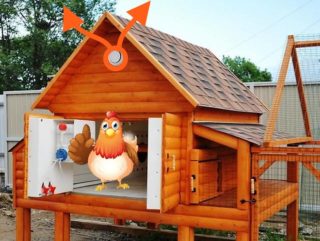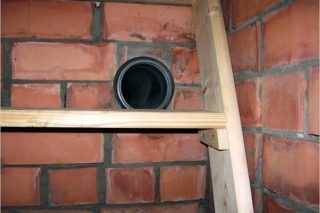For the successful maintenance of poultry, it is very important to properly organize ventilation in the chicken coop. The health of birds depends not only on the feed used, but also on the indoor microclimate, on light, humidity and temperature. If these indicators are below normal, the bulk will go to replenish energy, and not to build body weight and hatch eggs.
The need for proper ventilation for birds

Good ventilation equipment in a room where poultry is kept is necessary for the following reasons:
- Due to decaying droppings, vapors of ammonia and hydrogen sulfide are formed. They form a strong unpleasant odor and are very toxic to chickens.
- The need to regulate the temperature. For example, in the summer, overheating in the house negatively affects the health status of chickens.
- Maintaining normal humidity in the house. The indicator should be in the range from 60 to 80%. If the air is very dry, a large amount of dust is generated in the room. But increased moisture negatively affects the state of health of the bird. In such conditions, pathogenic bacteria begin to multiply actively.
Moisture in the chicken coop is formed due to dirty litter, which is rarely changed. If the room has good ventilation, moisture will go outside. Thanks to this, the air will become cleaner and warmer.
Varieties of ventilation systems
There are several ways to organize air exchange in the house.
Natural
The easiest and cheapest way to organize ventilation in the chicken coop is through ventilation. For this, through holes are mounted in the walls; during the day, windows and doors are additionally opened.
With this type of ventilation, drafts must be avoided. To do this, make small holes above the door. They will cut the flow of air, not allowing it to intensify. To make ventilation safe, you need to place the windows at different levels.
End-to-end ventilation is dangerous in the winter. Chickens can hardly tolerate cold and drafts. In roosters, scallops can freeze, in chickens, egg production decreases. To ensure normal conditions for the birds, it is necessary to organize additional heating in the winter, if ventilation will occur naturally.
Mechanical
In large rooms where poultry is kept, the use of a mechanical ventilation option is recommended. This is best done with a livestock of more than 50 chickens. This method will ensure optimal air exchange in any weather. In farms where there are few birds, the cost of electricity when installing the hood does not justify itself.
The mechanical way is to install fans. They can be complete with a control panel, can be adjusted manually.
Combined
Such a system is based on combining the supply and exhaust ventilation in one room.
The main requirements for ventilation in the chicken coop
In order for the ventilation system in the chicken coop to work efficiently, you need to follow the basic requirements for the room:
- It is necessary to provide the room with fresh air regularly.
- There should be no condensation on the ceilings and walls, which leads to the formation of fungus.
- A volume of air should be sufficient for all birds. The larger the livestock, the more fresh air is required. This can be achieved by choosing the right section of the duct.
- The ventilation system must be adjustable, this is necessary to reduce the risk of freezing in the winter. Flaps must be installed on the ducts. They will help to supply cold air in parts. In winter, the air ducts are covered with a fine mesh, and in severe frosts they are completely covered.
To determine if ventilation works correctly, you need to pay attention to your well-being in the house. If your head begins to feel dizzy, that means there is not enough oxygen.
No ventilation will solve the problem of clean air flow in a dirty chicken coop. If there is always a lot of litter indoors, it will emit ammonia vapors constantly.
Hood design
To choose the best option for the ventilation system in the chicken coop, you need to consider the following factors:
- number of individuals and volume of premises;
- frequency of cleaning;
- content in cells or in a free way.
The air exchange should be all the more intense, the more birds live on one square meter. A conventional hood can be installed if the farm contains no more than 20 chickens. For livestock up to 50 pieces, it is necessary to equip the supply and exhaust ventilation. A forced system is necessary if the chickens are more than 50. More intense air exchange must be ensured if the birds are kept in cages.
When drawing up the scheme, the following parameters must be considered:
- If you are making a hood in a chicken coop with plastic pipes yourself, for an area up to 12 square meters you need 2 meters of pipes with a diameter of 22 cm.
- For 1 kg of poultry, 4 m³ / h of supply air is required.
The flow of fresh air needs to be increased if it is not possible to often remove droppings.
Arrangement options
Most often, farms use the option of organizing natural or mechanical ventilation.
The natural option is a hole in the bottom of the door and the installation of a supply and exhaust pipe.
With mechanical ventilation equipment, a pipe is installed in the corner of the room, it is recommended that it be led out through the attic to the roof at a distance of 1.2 meters. If a hole is made in the wall for mechanical drawing, plastic pipes must be additionally connected with a corrugated tin bend.
A round shutter is installed on the upper part, which faces the street, it should protect from snow and rain.
Often in severe frosts due to condensation, the lumen of the pipe closes, and it is difficult to remove it. To avoid this, it is recommended that the outside of the pipe be directed downward. Due to this, it will be possible to avoid the formation of ice at the edges of the pipe and in its walls. Pipes need to be insulated with waterproofing material.
DIY ventilation in the chicken coop
Before you start work in the chicken house on the organization of air exchange, you need to make the correct calculation, which will be based on the number of birds and the area of the room. The design includes a variant of the ventilation system, the development of the scheme, taking into account the calculation of performance and the necessary material. When drawing up a project, you need to make the right area sizes.
Necessary materials
To make a mechanical system, you will need to prepare:
- a saw for wood or metal;
- nails, hammer, boards;
- bolts, rivets, stapler and staples;
- electric drill;
- thick paper;
- ruler, compass;
- metal or plastic pipes of the same size - 2 pieces.
To install exhaust ventilation, you will need one centrifugal fan, two tees for plumbing, pressureless pipes with a diameter of 110 mm, one valve, transitions with sections 110 and 124 in the amount of two pieces. You will also need to purchase a relay to adjust on and off.
Step-by-step instruction
Installation of ventilation in the chicken house is as follows:
- It is necessary to make a cut in the logs of the wall, it has a square shape. A ventilation pipe will be inserted into the hole. At least 10 cm should remain from the upper edge from the inside to the ceiling. The upper strapping log cannot be touched.
- A pipe is inserted into the finished hole and fastened with plywood with a square slot.
- To check whether the ventilation works correctly, you need to go into the chicken house in calm weather and close the door tightly behind you. Then attach a sheet of paper to the hole in the pipe. If it does not fall, but clings tightly to the pipe, ventilation works well.
- For large rooms, an additional fan must be installed.
To remove accumulated condensate, you need to attach a cork down the plastic tee. A metal fitting is screwed into it, on which you need to put on a narrow hose. It is designed to drain and collect moisture accumulated inside the pipe. The end of the hose is lowered into the canister. Accumulated droplets will drain down the pipe, accumulate in the tee, then flow through the hose to a special container.
The ventilation system is recommended to be equipped with means for adjusting the air flow. To do this, windows, vents are made, shutters are installed.
Features of the organization of the winter chicken coop
It is necessary to calculate the ventilation scheme in the chicken house in winter most carefully. Continuous air exchange is important for bird health. In winter, it is not possible to organize permanent natural ventilation, as this can lead to drafts and diseases of chickens. Indoors, during breathing, the volume of oxygen decreases, it is replaced by carbon dioxide. Because of this, the atmosphere becomes suffocating, damp. In such a room, birds live very hard. Without ventilation, they begin to hurt, they can die.
When installing ventilation pipes in a winter coop, the following features should be considered:
- If the house has a gable roof, the draw pipe must not go beyond the level of the ridge. In the case of chicken coops with a flat roof, the pipe should be lowered from the roof to a distance of 40 cm.
- The exhaust pipe must be placed at least 30 cm from the floor. This takes into account the size of the litter.
- Exhaust and supply pipes must be mounted in different sides of the room.
- In the elbow of the exhaust pipe from the street, you need to make a small hole of no more than 5 mm to drain the condensate.
The entire exhaust structure must be disassembled at least twice a year to clean it of accumulated dirt and dust.
If all the requirements and rules for the installation of ventilation in the chicken coop are observed, it will be possible to preserve the health of the birds and increase egg production.










